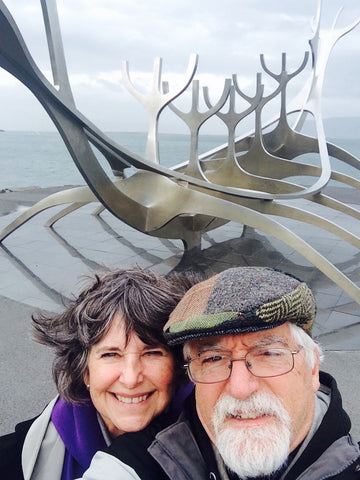About Us
About Us...

Fiskur (Icelandic for 'fish') Leather was started in 2011 after Pam Manthei and her husband, Joe, visited Iceland on vacation. What began as a curiosity with the beauty and design potential of fish leather quickly developed into a plan to supply this exotic product to fashion designers, crafters, fiber artists and hobbyists in the United States. Pam primarily uses a Juki sewing machine in her creative process. She also makes fish leather covered buttons and rolled leather beads out of fish leather. Beading & weaving are two other skills she has developed over the years. Yes - the fish leather can have beads sewn on! Quilt Art has been an exciting venture for Pam making various bird quilts and a large quilt showing downtown Reyjkavik.

Joe is the hand stitcher and rarely uses a sewing machine. (Rumor has it that the bobbin and he are not friends!) Starting with making bookmarks in 2011 he has progressed with his skills to create tote bags, wallets, briefcases, a salmon leather chess set and backpacks. He has also made moccasins and a quiver! Often called upon for leather repairs while at events - he is a master problem solver and enjoys the design process as much as the build phase.

About fish leather...
Fiskur Leather imports tanned fish leather from a specific tannery in Iceland. Fish leather is a shining example of how a by-product of food production can be utilized. The raw material is fish skin from fish caught at sea or farmed for food. Not a single hide in the tannery comes from an animal bred for its skin. If it's not used by the tannery it would simply be discarded. The hot water used for coloration and tanning is from geothermal sources, an environmentally friendly and renewable resource.

Fish leather, just like traditional leathers, is made by tanning animal skin which in this case is the skin from salmon, cod and wolfish. Tilapia has also been tanned in Iceland and has limited availability. Fish leather is thin, extremely strong for its size, and is highly sought by garment designers for its unique textures and finishes. Fish leather is pliable and easy enough to work with for home crafters and fiber artists. The strength and durability comes from the multiple layers which cross each other rather than running parallel with each other. This characteristic makes it resilient to stresses in any direction.

Once the skin has been de-scaled and de-fleshed it has very little natural color, so it readily accepts dye. There is a wide range of colors and variety of finishes. In consideration of all of the possible combinations of dyes, finishes & films - there is over 4000 possible selections for salmon alone. All of the fish leathers should be treated like all leathers from other species (calf, cowhide, lambskin, etc). It is not waterproof and should be treated to resist moisture. The nubuk (suede) finish has some elasticity, other finishes do not.

